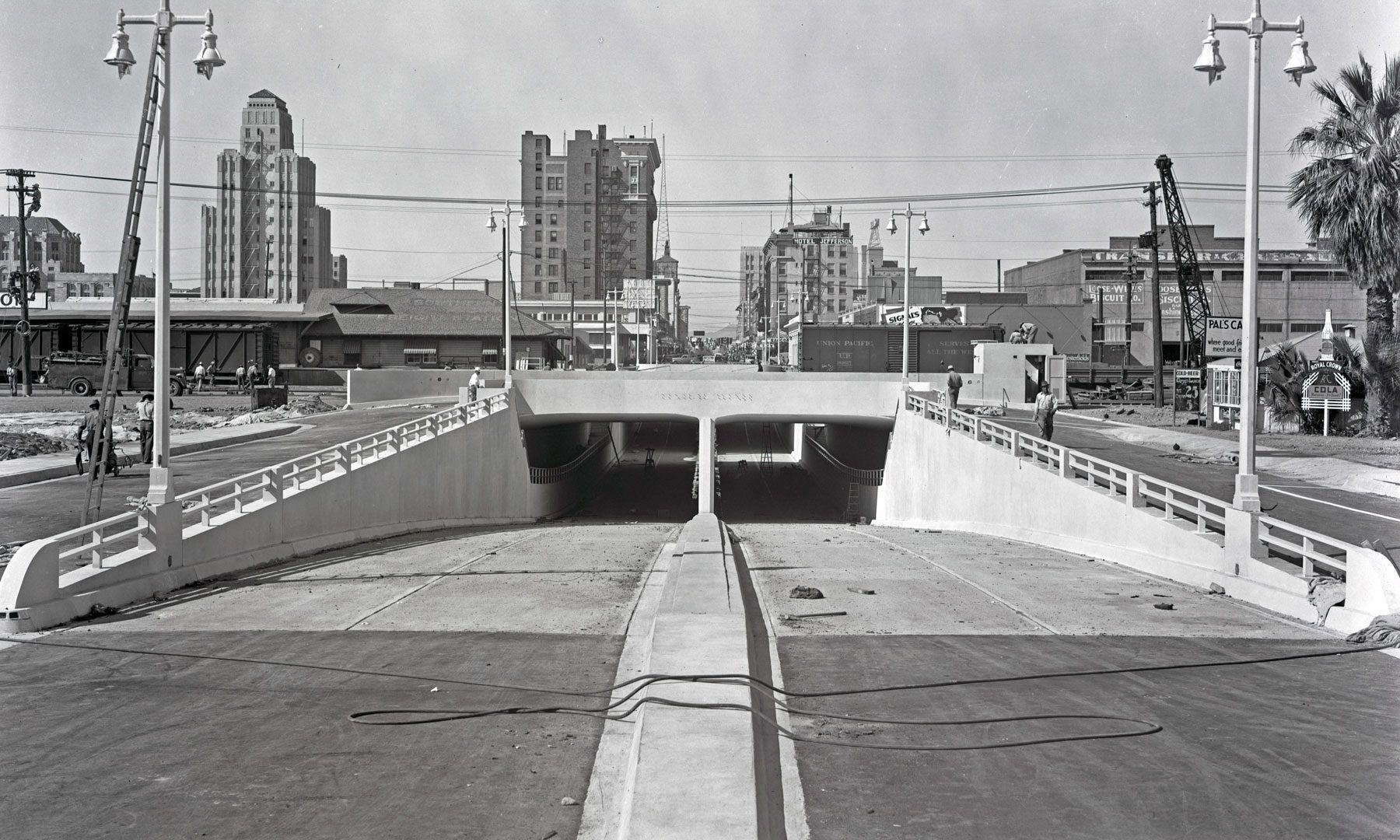
A view looking north at the Central Avenue underpass upon completion, 1940. (Photo: McCulloch Brothers, Inc., Arizona State University Libraries)
Phoenicians who enjoy underground haunts, or merely the opportunity to toot their own horn, like to approach downtown from the south via the Central Avenue underpass. The beautiful, streamlined concrete structure features winged motifs and “Central Avenue” rendered in aluminum letters on corbelled pylons.
Completed in 1940 to pass under both the Southern Pacific and Santa Fe railroad tracks, the subterranean corridor has evolved into one of the city’s most notable wormholes.
“It’s a passage from one era to another, from an Art Moderne structure to a modern 20th-century city of tall glass buildings,” says historian Donna Reiner. “The effect is even greater at twilight.”

Looking south at the completed Central Avenue underpass with the Warehouse District and South Phoenix in the distance, 1940. (Photo: McCulloch Brothers, Inc., Arizona State University Libraries)
In the late-1930s, 75 daily trains and their rails were treacherous impediments to the 14,000 autos that traveled back and forth on Central Avenue between south Phoenix and downtown.
Prior to the underpass being constructed, accidents were common. Reg Manning, a cartoonist for The Arizona Republic, regularly satirized the crossing, drawing cars rearing and plunging like bucking broncos over the multi-track traffic hazard that locals termed the “cascades.”

The Central Avenue underpass under construction in 1939. (Photo: Sheldon Spry Collection, Arizona Room, Phoenix Public Library)
The Arizona Highway Department had used federal funds to construct a nearby railroad underpass at 17th Avenue in 1935, which improved traffic flow along U.S. Highway 80.
As early as 1928, the Phoenix Junior Chamber of Commerce proposed construction of a Central Avenue four-lane underpass. The Great Depression delayed work until 1939, with the Arizona Highway Department as the designer/engineer and Lee Moor Contracting of El Paso, Texas undertaking the construction.
In June 1939, the project started with excavation and driving piles to support trestles for the railroad tracks.

A newspaper photo of the Central Avenue underpass one day after opening, 1940. Photo: “The Arizona Republic”)
“At age 18, I was a truck foreman and driver for J.D. Williams,” 96-year-old James Bond recalled in 2018. “We had the contract with Lee Moor to remove all the dirt in three months under the tracks to make way for the new road.”
Bond’s friend, Robert E. Canion Jr., had just launched Canion Construction and Excavation and worked on the project.
“I used my mules to compact the roadbed,” the 101-year-old said in a 2018 interview. Canion recalled driving his mule team to the job and home again, sort of like a cattle drive.

Robert E. Canion, Jr. and James Bond (left to right) pictured in 2018 during an interview with the author. (Photo: Douglas C. Towne)
Activity at the job site came to a halt in November because of a strike called by the American Federation of Laborers (AFL) to force Lee Moor to become an exclusive union firm. Lee Moor settled with the AFL later that year, and the company completed the work on time in May 1940.
The underpass, designed to military standards, could accommodate two light army tanks traveling abreast in each lane. A modern electrical system made the tunnel the best-lighted section of Phoenix roadway.

Current view of the Central Avenue underpass looking north, currently under construction for a light rail extension that will connect downtown to south Phoenix by rail. (Photo: Fara Illich, 2022)
The underpass opened with fanfare — speeches, a parade, and a street dance, according to a 1940 Republic article. The Phoenix Union High School band led a caravan of dignitaries in more than 50 motor cars through the underpass. Boy Scouts distributed commemorative windshield decals to the first 5,000 vehicles to transit the tunnel.
The underground corridor proved to be a safe and speedy pathway that facilitated the warehouse district and south Phoenix development. However, it’s unknown if any army tanks ever used the underpass.
About the author: In 2018, to better understand the Central Avenue underpass that provided vital federal funds to Arizona during the Great Depression, Douglas C. Towne located and interviewed two local construction pioneers, James Bond and Robert E. Canion, Jr., who helped build the structure in their youth. Towne is a freelance writer, hydrologist, historian and artist.







